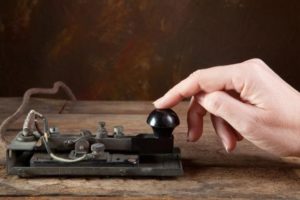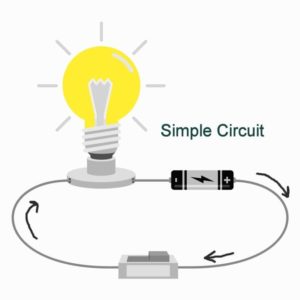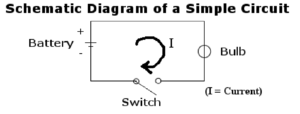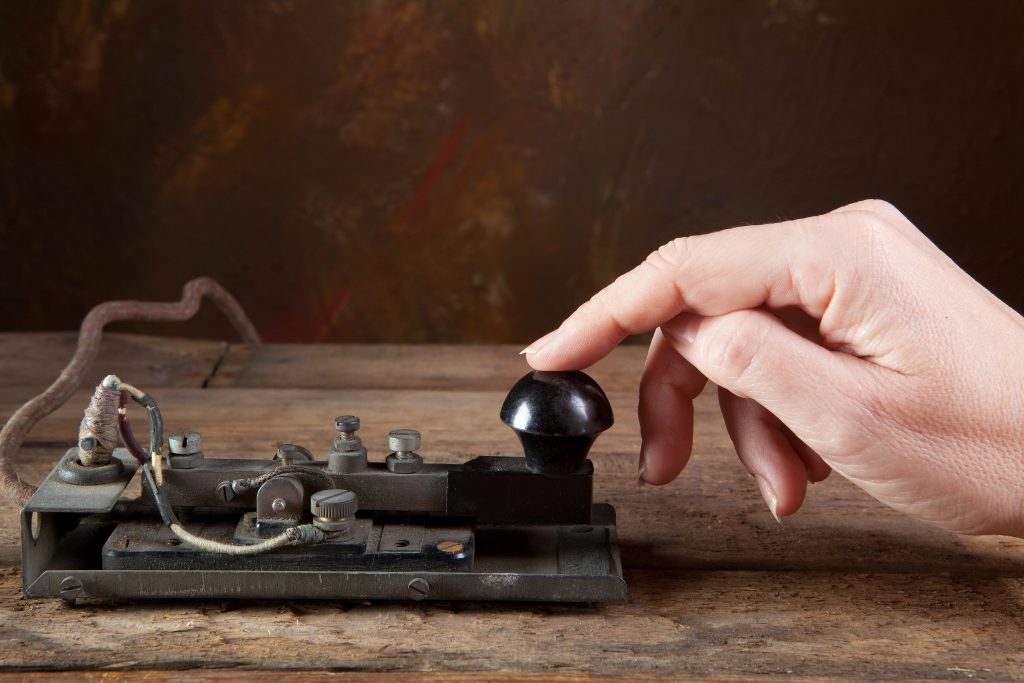This lesson focuses on exploring electric message systems, from light signals using International Morse Code to text messaging. Students construct a simple telegraph using a battery, wires, a switch, and bulb, and explore the impact of communications on society.
- Learn about electrical based communications.
- Learn about the Morse Code system.
- Learn about wiring, switches, and simple circuits.
- Learn about teamwork and problem solving.
- Learn about the history of communication and its impact on world events.
Age Levels: 8-14
Materials & Preparation
Build Materials (For each team)
Required Materials
- Insulated wire
- D size Battery
- D size Battery Holder
- 1.5 volt bulb socket
- 1.5 volt bulb
Alternative Materials
- PacSci Morse Code Kit is available from many retailers online.
Testing Materials
- Large piece of cardboard
Testing Materials & Process
Materials
- Large piece of cardboard
Process
- Have each team devise a “secret” message to send to another team using the Morse Code system.
- The teams should practice the lighted code message a few times so that it is clear and readable. (Hint: press the switch for a short time to show a dot (.), hold it longer to display a dash (-).
- Place a piece of cardboard between two teams, so that they cannot see the “message” except in the process of deciphering the light code.
- Have each team decode the partner team’s message.
Engineering Design Challenge
Design Challenge
You are part of a team of engineers given the challenge of building a working circuit with a battery, wires, and a bulb. You must add a switch in such a way that it turns the bulb on and off.
Criteria
- Must have a switch that can turn the bulb on and off.
Constraints
Use only the materials provided.
Activity Instructions & Procedures
- Break class into teams of 2
- Hand out the Electric Messages: Then and Now worksheet, as well as some sheets of paper for sketching designs.
- Discuss the topics in the Background Concepts Section. Review International Morse Code in the Background Concepts Section. If students aren’t familiar with a simple circuit, give an overview using the Background Concepts Section.
- Review the Engineering Design Process, Design Challenge, Criteria, Constraints and Materials. Consider asking students what it would be like to use the Morse Code system on their cell phone.
- Provide each team with their materials.
- Explain that students must build a working circuit with a battery, wires, and a bulb. They must add a switch in such a way that it turns the bulb on and off.
- Announce the amount of time they have to design and build (1 hour recommended).
- Use a timer or an on-line stopwatch (count down feature) to ensure you keep on time. (www.online-stopwatch.com/full-screen-stopwatch). Give students regular “time checks” so they stay on task. If they are struggling, ask questions that will lead them to a solution quicker.
- Students meet and develop a plan for their circuit and switch. They should sketch their circuit and switch on paper before building.
- Teams build their circuits and switches.
- For testing:
- Have each team devise a “secret” message to send to another team using the Morse Code system.
- The teams should practice the lighted code message a few times so that it is clear and readable. (Hint: press the switch for a short time to show a dot (.), hold it longer to display a dash (-).
- Place a piece of cardboard between two teams, so that they cannot see the “message” except in the process of deciphering the light code.
- Have each team decode the partner team’s message
- As a class, discuss the student reflection questions.
- For more content on the topic, see the “Digging Deeper” section.
Extension Ideas
- Have students devise your own code to send messages. This could be done with light, sound, whatever they can think of.
- Have a third student group try to intercept the message being transmitted by the first two teams.
Student Reflection (engineering notebook)
- What did the other team’s message say?
- Did you have any challenges understanding the other team’s message? If so, what?
- What did your team’s message say?
- Did the other team understand your message? If not, what went wrong?
- If your team were delivering a message critical to world safety…what would have happened?
Time Modification
The lesson can be done in as little as 1 class period for older students. However, to help students from feeling rushed and to ensure student success (especially for younger students), split the lesson into two periods giving students more time to brainstorm, test ideas and finalize their design. Conduct the testing and debrief in the next class period.
Engineering Design Process
Background Concepts
History of Electronic Communications
What Samuel Did
Samuel F. B. Morse, while a professor of arts and design at New York University in 1835, proved that signals could be transmitted by wire. He used pulses of current to deflect an electromagnet, which moved a marker to produce written codes on a strip of paper -the invention of Morse Code. The following year, the device was modified to emboss the paper with dots and dashes. He gave a public demonstration in 1838, but it was not until five years later that Congress — reflecting public apathy — funded $30,000 to construct an experimental telegraph line from Washington to Baltimore, a distance of 40 miles. Six years later, members of Congress witnessed the sending and receiving of messages over part of the telegraph line.
AnnekaS-bigstock.com
Spreading News
Today, with instant messaging, we can hardly imagine that 150 years ago it might take months for word of the outcome of a presidential election to spread. But Morse’s invention tapped into the potential the electronic communication that is so prevalent today. On May 24, 1844 the U.S. Democratic National Convention was held in Baltimore, Maryland. Van Buren seemed the likely choice, but his opponent, James K. Polk, won the nomination. This news was telegraphed immediately to Washington, but skeptics refused to believe it. Only after persons arrived by train from Baltimore to confirm the reports were many convinced of the telegraph’s value. Now we’ve come to trust electronic communication, and to even take it for granted! But…did you know that until 1999, International Morse Code, tapped out on a telegraph key, remained the international standard for long-range maritime communication.
HelleM-bigstock.com
Text Messaging or SMS
Text messaging or SMS (short message service) sends text between cell phones, or from a computer or other handheld device to a cell phone. Why “short?” At present, the longest text message is 160 letters, numbers, or symbols in the Latin alphabet. And, for other alphabets like Chinese, the cap is only 70 characters. Here’s how it works: your cell phone continually sends and receives connectivity messages from phone towers. This confirms the “cell” in which you are physically located; cells are usually about 10 square miles. A text message uses the same system through which you receive calls. But, the information is sent/received in either text mode or by PDU (protocol description unit) mode. Sound familiar? Likely Samuel Morse would approve!International Morse Code Rules
International Morse Code
What is called Morse code today is actually a bit different from what Samuel Morse originally created. In 1848, some changes to the code sequences and to eleven letters were introduced in Germany and are now recognized as the worldwide standard called “International Morse.” The code changes a bit over time. For example, the “@” symbol was added in 2004, combining A and C into one character.Symbol Recognition
By using electric bursts to send messages in Morse Code, information can be sent in a relatively private way. The code may be sent electrically using sound or lights. In this lesson, we’ll be using a switch and light apparatus to demonstrate the Morse code system. The use of lights for spelling out messages in Morse code dates back to 1867. With the advent of electric lights in the 1890s, the “blinker light” became an effective tool for signaling.Letter Code Letter Code Letter Code Number Code Symbols Code A ·- N -· ä ·-·- 0 —– Period [.] ·-·-·- B -··· O — à ·–·- 1 ·—- Comma [,] –··– C -·-· P ·–· ĉ -·-·· 2 ··— Question mark [?] ··–·· D -·· Q –·- ch —- 3 ···– Apostrophe [‘] ·—-· E · R ·-· ð ··–· 4 ····- Exclamation [!] -·-·– F ··-· S ··· è ·-··- 5 ····· Slash [/] -··-· G –· T – é ··-·· 6 -···· Ampersand [&] · ··· H ···· U ··- ĝ –·-· 7 –··· Colon [:] —··· I ·· V ···- ĥ -·–· 8 —·· Semicolon [;] -·-·-· J ·— W ·– ĵ ·—· 9 —-· Hyphen [-] -····- K -·- X -··- ñ –·– At sign [@] ·–·-· L ·-·· Y -·– ö —· Underscore [_] ··– ·- M — Z –·· ü ··– John George Phillips Legacy
Titanic Hero
Most people are familiar with the Titanic disaster, when about 1500 people perished as the Titanic sunk after striking an iceberg in 1912. Many people blame the ship’s designer for not equipping the Titanic with enough life boats to save all individuals on the maiden voyage. But some people might also look to the spirit of John George Phillips, who looked to the new technology of telegraph, based on Samuel Morse’s Code to continually send frequent cries for help on the wire. John was called “Jack” or “Sparks” Phillips because he “morsed” so fast! Because of his efforts, many were saved who would have likely perished in the frosty waters of the Atlantic.In a statement made in 1998 by the President of the American Radio Association as submitted to the United States House Subcommittee on Employer-Employee Relations:
- “From the time John Phillips sent an SOS in Morse Code from the S/S Titanic, Radio Operators have provided the safety communications network necessary for mariners throughout the world. It was the sinking of the Titanic in 1912 that made the importance of the shipboard Radio Operator/Radio Officer unforgettably clear for decades to come. The dedicated and courageous Chief Radio Operator John G. Philips refused to abandon his post at the wireless radio as the Titanic sank. Over 700 lives were saved that night in the icy waters of the North Atlantic because of his heroic actions.
- While the technology of receiving and transmitting wireless telegraphy has advanced a great deal since the Titanic, the role of the ship’s Radio Operator remained constant, to maintain, repair and use the network of ship-to-ship wireless communications to bring swift response to emergencies at sea. An “SOS” sent in Morse Code has literally saved the lives of tens of thousands of crew and passengers who were plucked from the sea because of this safety network and its shipboard radio operators. When accidents occurred at sea, the radio telegraph officer was always known as the mariners’ and passengers’ best chance for survival
- As a result, the need for a dedicated communications specialist was recognized in the Ship Act of 1919 that required ocean-going passenger vessels to carry skilled radio personnel to monitor and operate the wireless. International treaties signed after the Titanic disaster created a role for radio operators aboard cargo ships and established a U.S. agency that would eventually become the FCC (Federal Communications Commission), to monitor the airwaves and license radio operators.”
What is a Simple Circuit?
Simple Circuit

yusufdemirci-Bigstock.com
A simple circuit consists of three minimum elements that are required to complete a functioning electric circuit: a source of electricity (battery), a path or conductor on which electricity flows (wire) and an electrical resistor (lamp) which is any device that requires electricity to operate. The illustration below shows a simple circuit containing, one battery, two wires, a switch, and a bulb. The flow of electricity is from the high potential (+) terminal of the battery through the bulb (lighting it up), and back to the negative (-) terminal, in a continual flow when the switch is in the on position so current can flow.Schematic Diagram of a Simple Circuit
The following is a schematic diagram of the simple circuit showing the electronic symbols for the battery, switch, and bulb.

IEEE/tryengineering.org
Simulating a Switch by Disconnecting a Wire
You can make a crude switch just by disconnecting one of the wires and alternately touching it and removing it from the metal case of the bulb. Why does the light go off when the wire is no longer touching? When the wire is removed, the electrons would have to flow through the air in order to complete the circuit. To make electrons flow through air requires a lot more energy than is available, because nearly all the electrons in the air are tightly bound to atoms. The same is true of all the other materials known as insulators. The makeshift switch that is made by disconnecting and reconnecting the wire does exactly the same thing as a manufactured switch, except that manufactured ones are more reliable. All they do is disconnect and reconnect the wires when you move the lever, push the button, turn the knob, or slide the button.Vocabulary
- Constraints: Limitations with material, time, size of team, etc.
- Criteria: Conditions that the design must satisfy like its overall size, etc.
- Engineers: Inventors and problem-solvers of the world. Twenty-five major specialties are recognized in engineering (see infographic).
- Engineering Design Process: Process engineers use to solve problems.
- Engineering Habits of Mind (EHM): Six unique ways that engineers think.
- Iteration: Test & redesign is one iteration. Repeat (multiple iterations).
- Morse Code System: A system of sending messages that uses long and short sounds or dots and dashes to represent letters and numbers.
- Prototype: A working model of the solution to be tested.
- Samuel F. B. Morse: Inventor of the Morse Code System.
- Simple Circuit: Consists of three minimum elements that are required to complete a functioning electric circuit: a source of electricity (battery), a path or conductor on which electricity flows (wire) and an electrical resistor (lamp) which is any device that requires electricity to operate.
- SMS (Short Message Service)/Text Messaging: Sends text between cell phones, or from a computer or other handheld device to a cell phone.
- Telegraph: A system by which messages may be sent by electronic means. Puts messages in code and sends them along wires.
Dig Deeper
Internet Connections
- The Titanic Radio Page
- Morse Code Translator
- Porthcurno Telegraph Museum
- SMS and the PDU format
- Privateline.com: Cellular Telephone Basics
- Morse Code Converter
Recommended Reading
- Morse Code Operating for Amateur Radio (ISBN: 978-1625950024)
Writing Activity
Write an essay or a paragraph exploring the engineering behind how satellite radio works. What prior inventions were required in order to generate this new technology? Why do cars equipped with satellite radio lose the signal when in a garage or tunnel?Curriculum Alignment
Alignment to Curriculum Frameworks
Note: Lesson plans in this series are aligned to one or more of the following sets of standards:
- U.S. Science Education Standards (http://www.nap.edu/catalog.php?record_id=4962)
- U.S. Next Generation Science Standards (http://www.nextgenscience.org/)
- International Technology Education Association’s Standards for Technological Literacy (http://www.iteea.org/TAA/PDFs/xstnd.pdf)
- U.S. National Council of Teachers of Mathematics’ Principles and Standards for School Mathematics (http://www.nctm.org/standards/content.aspx?id=16909)
- U.S. Common Core State Standards for Mathematics (http://www.corestandards.org/Math)
- Computer Science Teachers Association K-12 Computer Science Standards (http://csta.acm.org/Curriculum/sub/K12Standards.html)
National Science Education Standards Grades K-4 (ages 4-9)
CONTENT STANDARD B: Physical Science
As a result of the activities, all students should develop an understanding of
- Light, heat, electricity, and magnetism
CONTENT STANDARD F: Science in Personal and Social Perspectives
As a result of activities, all students should develop understanding of
- Science and technology in society
CONTENT STANDARD G: History and Nature of Science
As a result of activities, all students should develop understanding of
- History of science
National Science Education Standards Grades 5-8 (ages 10-14)
CONTENT STANDARD B: Physical Science
As a result of their activities, all students should develop an understanding of
- Transfer of energy
CONTENT STANDARD E: Science and Technology
As a result of activities in grades 5-8, all students should develop
- Abilities of technological design
- Understandings about science and technology
CONTENT STANDARD F: Science in Personal and Social Perspectives
As a result of activities, all students should develop understanding of
- Science and technology in society
CONTENT STANDARD G: History and Nature of Science
As a result of activities, all students should develop understanding of
- History of science
National Science Education Standards Grades 9-12 (ages 14-18)
CONTENT STANDARD B: Physical Science
As a result of their activities, all students should develop understanding of
- Interactions of energy and matter
CONTENT STANDARD E: Science and Technology
As a result of activities, all students should develop
- Abilities of technological design
- Understandings about science and technology
National Science Education Standards Grades 9-12 (ages 14-18)
CONTENT STANDARD F: Science in Personal and Social Perspectives
As a result of activities, all students should develop understanding of
- Science and technology in local, national, and global challenges
- Historical perspectives
Next Generation Science Standards – Grades 3-5 (Ages 8-11)
Students who demonstrate understanding can:
- 4-PS3-4. Apply scientific ideas to design, test, and refine a device that converts energy from one form to another.
Waves and Their Applications in Technologies for Information Transfer
Students who demonstrate understanding can:
- 4-PS4-3. Generate and compare multiple solutions that use patterns to transfer information.
Engineering Design
Students who demonstrate understanding can:
- 3-5-ETS1-1.Define a simple design problem reflecting a need or a want that includes specified criteria for success and constraints on materials, time, or cost.
- 3-5-ETS1-2.Generate and compare multiple possible solutions to a problem based on how well each is likely to meet the criteria and constraints of the problem.
- 3-5-ETS1-3.Plan and carry out fair tests in which variables are controlled and failure points are considered to identify aspects of a model or prototype that can be improved.
Next Generation Science Standards – Grades 6-8 (Ages 11-14)
Engineering Design
Students who demonstrate understanding can:
- MS-ETS1-2 Evaluate competing design solutions using a systematic process to determine how well they meet the criteria and constraints of the problem.
Standards for Technological Literacy – All Ages
The Nature of Technology
- Standard 1: Students will develop an understanding of the characteristics and scope of technology.
- Standard 3: Students will develop an understanding of the relationships among technologies and the connections between technology and other fields of study.
Standards for Technological Literacy – All Ages
Technology and Society
- Standard 4: Students will develop an understanding of the cultural, social, economic, and political effects of technology.
- Standard 6: Students will develop an understanding of the role of society in the development and use of technology.
- Standard 7: Students will develop an understanding of the influence of technology on history.
Abilities for a Technological World
- Standard 13: Students will develop abilities to assess the impact of products and systems.
The Designed World
- Standard 17: Students will develop an understanding of and be able to select and use information and communication technologies.
Related Engineering Fields and Degrees
Student Worksheet
Simple Switch Demonstrating International Morse
Did you know?
“Electric Messages: Then and Now” in International Morse Code is:
.-.. . -.-. – .-. .. -.-. / — . … … .- –. . … —… / – …. . -. / .- -. -.. / -. — .–
Build Your Own!
Step One:
- Design a working circuit incorporating a battery and a bulb on paper.
- Build your working circuit design using a battery, wires, and a bulb.
- Next, add a switch in such a way that the switch turns the bulb on and off.
Step Two:
- Devise a “secret” message to send to another student group.
- Practice “sending” the message using International Morse Code until you are confident the other team will understand your message. (Hint: press the switch for a short time to show a dot (-), hold it longer to display a dask ().
- http://www.privateline.com/Cellbasics/Cellbasics.html
Optional Idea One:
Devise your own code to send messages. This could be done with light, sound, whatever you can think of!
Optional Idea Two:
Have a third student group try and intercept the message being transmitted in Step Two above.
Questions:
- What did the other team’s message say?
- Did you have any challenges understanding the other team’s message? If so, what?
- What did your team’s message say?
- Did the other team understand your message? If not, what went wrong?
- If your team were delivering a message critical to world safety…what would have happened?
Translations





 Industrial Engineering
Industrial Engineering
 Computer Engineering
Computer Engineering